July 2013 LIP of the Month
Global intracratonic boninitic-norite magmatism during the Neoarchean-Paleoproterozoic – revisited
Rajesh K. Srivastava1 & Richard E. Ernst2
1Centre of Advanced Study, Department of Geology, Banaras Hindu University, Varanasi 221 005, India
(e-mail: rajeshgeolbhu@gmail.com)
2Department of Earth Sciences, Carleton University, Ottawa, K1S 5B6, and Ernst Geosciences 43 Margrave Ave., Ottawa K1T 3Y2, Canada
Extracted and modified from Srivastava (2006, 2008)
Abstract
Boninitic-noritic (BN) magmatism is a common feature during the Neoarchean–Paleoproterozoic and has occurred in a number of Archean cratons of the globe. This magmatism chiefly occurs as intrusions (dykes and layered intrusions), which are typically emplaced in intracratonic settings, and have been considered as part of the plumbing system of Large Igneous Provinces (LIPs). Related volcanic rocks, SHMB (siliceous high magnesium basalts) also occur in the Neoarchean. The BN suite of rocks are contain high Si (>52 wt%), high Mg (>8 wt%), and low Ti (mostly <0.5 wt%), and are inferred to be derived from melting of a refractory mantle. For similar boninitic (sensu stricto) magmatism (mainly from the Phanerozoic) the refractory mantle is melted due to metasomatism above a subduction zone. However, the timing of BN magmatism (mainly during a period from Neoarchean to Paleoproterozoic) is linked to cratonization which was associated with crustal thickening at the end of Archean. Prior to cratonization, extensive extraction of mafic magma (forming the widespread late Archean greenstone belts) developed a complementary refractory mantle forming the lithospheric root which was metasomatised by subduction associated with the assembly at ca. 2.7 Ga of many Archean cratons. Finally, partial melting of metasomatised refractory mantle due to the arrival of numerous discrete mantle plumes produced boninite-type melts during Neoarchean–Paleoproterozoic time. It is inferred that the geochemical compositions of boninitic (high-Ca derivative) and noritic (low-Ca derivative) end members suggest a co-magmatic relationship through a high-magnesium boninite-type melt derived from a highly refractory mantle. Low-Ca variety (norite) is a differentiated product of the high-Ca variety and, therefore, contains slightly enriched geochemical composition. Emplacement of BN suites is linked to LIP events associated with the breakup of Archean continents.
Introduction and Classification of High-Mg (Boninitic-Noritic) Mafic Igneous Rocks
There is a strong secular change in high-magnesium (high-Mg) mafic magmatism and tectonic setting over time as earlier noted by Hall and Hughes (1990b, 1993) (Fig. 1). For example – (1) komatiitic-series rocks are reported from many Archean greenstone belts and inferred to be mostly derived from arrival of a mantle plume (e.g., Arndt and Nisbet, 1982; Asahara and Ohtani, 2001; Arndt et al., 2008), however a subduction origin is also argued (e.g., Brooks and Hart 1972, 1974; Wilson and Versfeld, 1994; Parman and Grove, 2005), (2) BN rocks (also termed high-Mg norites) and their extrusive volcanic equivalent SHMB are reported from Neoarchean to Paleoproterozoic and emplaced mostly in intracratonic rift or plume settings (Halls and Hughes, 1990a, b, 1993; Barnes et al., 2012; Smithies, 2002; Smithies et al., 2004; Srivastava, 2006, 2008) and are linked to LIPs (e.g., Hall and Hughes 1993; Cadman et al. 1997; Ernst and Buchan, 2001), and (3) boninite/boninite-like rocks are mostly reported from the Phanerozoic and confined to convergent margin settings (Crawford et al., 1989; Tatsumi and Maruyama, 1989; Kim and Jacobi, 2002; Smithes et al., 2004). High-Mg andesites are also associated with convergent margin settings (Kelemen, 1995; Tatsumi et al., 2003; Tatsumi, 2006). Many have proposed that boninites and the geochemically similar high-Mg andesites also have similar nature and subduction genesis (e.g. Kim and Jacobi, 2002).
Herein focus is given to the latter two types: BN (high-Mg norites)/SHMB and boninite/boninite-like rocks. In terms of geochemistry, boninites, BN and SHMB have broadly similar geochemical compositions; all contain high-magnesium (MgO>8%), high-silica (SiO2>52%) and low-titanium (TiO2<0.5%) and these three types are not distinguished by standard chemical classification schemes. According to the IUGS classification scheme (Le Bas, 2000; Le Maitre, 2002), igneous rocks with MgO >12%, SiO2 between 30 and 52% and Na2O+K2O <3% are classified as boninite, picrite or komatiite on the basis of differences in these oxides and TiO2; boninites have MgO >8%, SiO2 >52% and TiO2 <0.5%, whereas basalts have MgO >12%, SiO2 between 30 and 52% and Na2O+K2O <3% without any consideration of TiO2. On the other hand, komatiite/meimechites have MgO >18%, SiO2 between 30 and 52% and Na2O+K2O <2%; if TiO2 is < 1%, it is regarded as komatiite, and if TiO2 > 1%, it is meimechite. This IUGS scheme does not include either high-Mg andesite or SHMB or high-Mg norite. Therefore, to classify these types, additional parameters must be used; see Table 1 for more details. For example, the high-Mg andesite has higher values of TiO2 and Zr and lower Al2O3/TiO2 ratio than the boninite. Furthermore, the Al2O3/CaO ratio is also used to classify high-Mg mafic igneous rocks into high-Ca and low-Ca (Type 3) boninites (Crawford et al., 1989); high-Ca boninites show typical boninitic geochemical characteristics, whereas low-Ca variety shows geochemical characteristics similar to BN magmatism (high-Mg norites). Siliceous high-magnesium basalts (SHMB) show similar geochemical properties to BN magmatism.
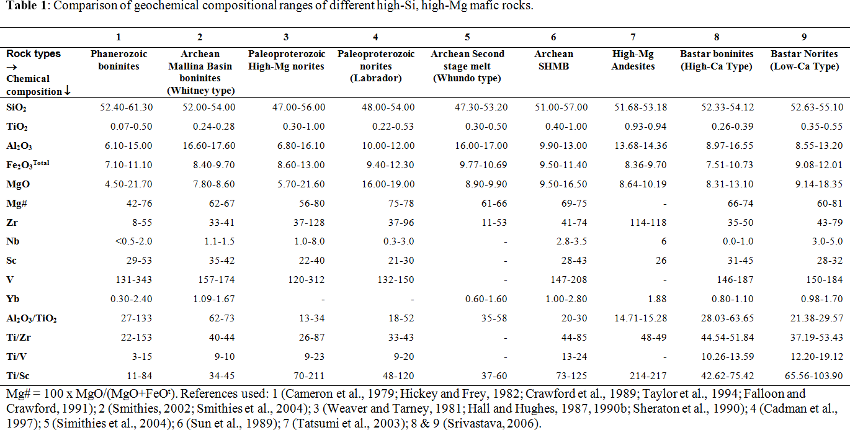
It is believed that some SHMB may also be a volcanic equivalent of BN rocks (Sun et al., 1989; Hall and Hughes, 1990b). Most SHMBs are Precambrian in age, however recently a Permian SHMB is also reported from the Xinjiang, NW China which is derived from hydrous and depleted mantle source (Gao and Zhou, 2013). Various constraints on the origin of SHMB have been proposed (Sun et al., 1989) and different SHMB may have different origins. Models for origin include: (1) that they are the Archean equivalent of modern boninites and form in an Archean subduction setting, (2) that they are derived from metasomatised refractory mantle sources (Sun and Nesbit, 1978), or (3) that they are derived through assimilation-fractional crystallization (AFC) processes of a parental komatiite magma (e.g., Arndt and Jenner, 1986; Arndt et al., 1987; Sun et al., 1989; Barnes et al., 2012).
Smithies et al. (2004) have discussed, in length, about the petrogenesis of Archean BN suites in space and time and classified them into two types – Whundo and Whitney. They further suggested that petrogenesis of the Whundo-type boninite is similar to that of modern boninites (i.e. subduction related) and these may be considered the closest Archean analogues of modern boninites, whereas the Whitney-type ‘boninites’ have a wide range of conditions and components and derived from an extremely depleted garnet-rich source. The Whiney-type boninitic magma may be generated by plume-induced melting of (subduction modified?) refractory mantle.
We further consider the origin of the Neoarchean and Palaeoproterozoic BN suite rocks, and note their global distribution and characteristic emplacement in an intracratonic rift or hotspot (plume) setting and derived from a metasomatized refractory mantle (Hall and Hughes, 1987; 1990b; Kuehner, 1989; Srivastava, 2006, 2008).
Worldwide Occurrences of Boninite-Norite Mafic Rocks and Possible Genesis
The global distribution of intracratonic Neoarchean–Paleoproterozoic boninite-norite (BN) suites from different terrains is shown in Figure 2, and details are summarized in Table 2. BN suites are well documented from southern West Greenland, East Antarctica, Labrador, Wyoming, the southern São Francisco craton (Brazil), Scourie (northwest Scotland), the eastern Fennoscandian shield and the southern Bastar craton (central India), in addition to many layered complexes, such as Stillwater, Bushveld, Jimberlana, examples from northern Finland, and the Great Dyke of Zimbabwe. Average geochemical composition (see Table 3) of most of these BN suite of rocks are very similar and exhibit comparable multi-element trends (Fig. 3) suggesting their origin through some common mechanism (Srivastava, 2008) as discussed above. Low concentrations of high-field strength elements in these rocks probably indicate a high degree of mantle partial melting.
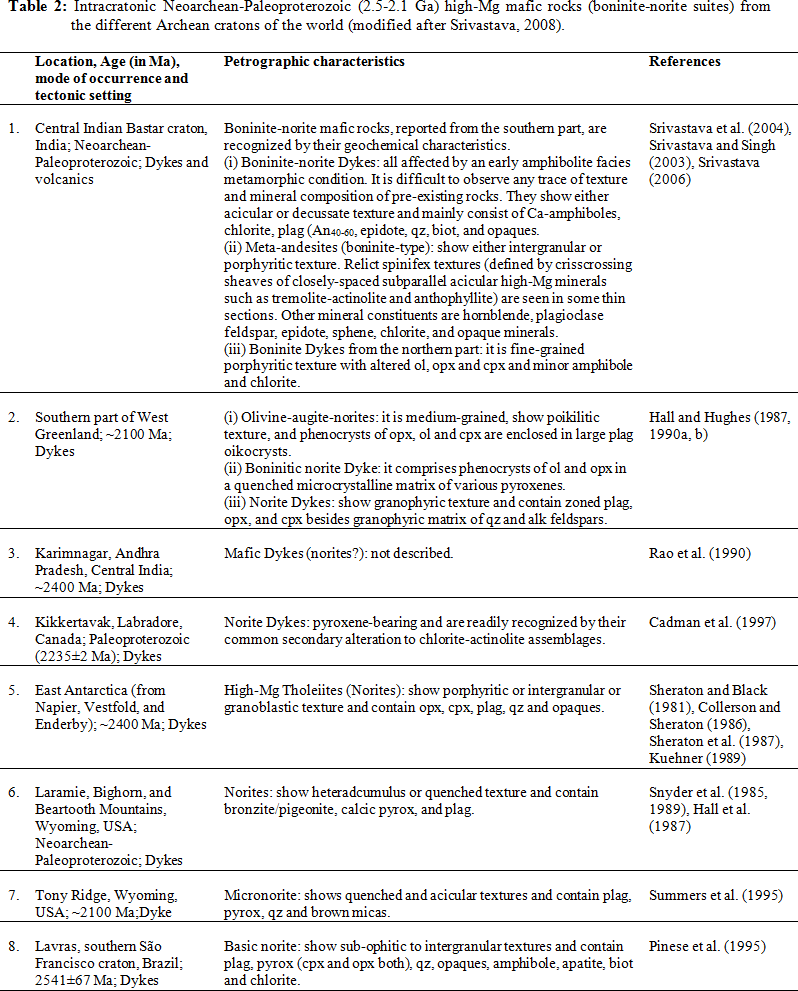
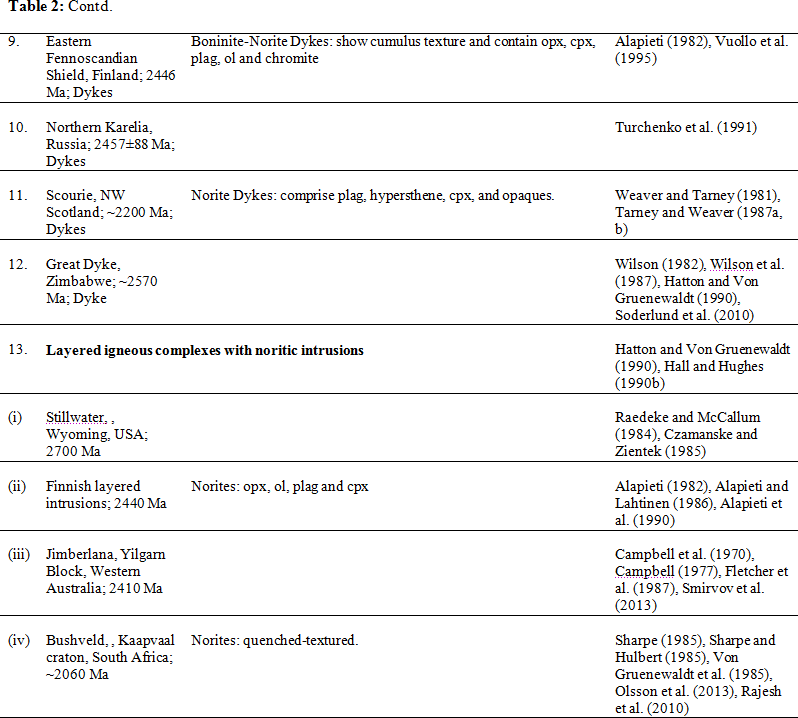
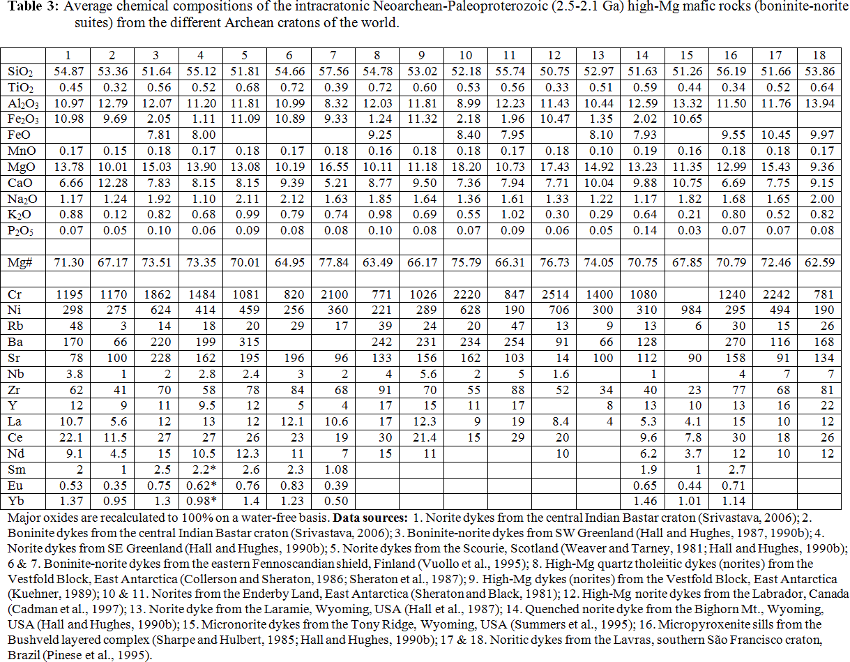
From the Table 2 and Figure 1 it can be clearly suggested that BN suite of rocks are emplaced during a very restricted period of time, i.e. ~ 2.5–2.1 Ga (Neoarchean–Paleoproterozoic), and represent a considerable volume of mafic magmatism (Hall and Hughes, 1990b). Importantly, most of these BN suites occur as plutonic or hypabyssal intrusions and are not associated with Archean komatiite magmatism (Hall et al., 1987; Hall and Hughes, 1990b). Hall and Hughes (1990b, 1993) observed that there is a clear anomaly in the nature of mafic magmatic assemblages formed during the Neoarchean–Paleoproterozoic that suggests considerable changes in mafic magmatic style from that in the earlier Archean.. Their model (Figure 1) clearly suggests the end of komatiite magmatism toward the end of the Neoarchean and an immediate switch to (boninite-) norite magmatism. They propose that this change is a consequence of crustal thickening, which promoted the partial melting of a refractory mantle that was replenished during metasomatism by LILE- and LREE-enriched hydrous fluids at the end of the Archean. The voluminous outpouring of mafic magma prior to global BN magmatism is thought to be principal reason for developing a refractory mantle (Sun et al., 1989; Hall and Hughes, 1990b, 1993; Smithies, 2002; Srivastava, 2006; Chalapathi Rao and Srivastava, 2009). Widespread crustal thickening and growth and stabilization of cratonic lithosphere at the end of Archean are supported by substantial geological and isotopic evidence (Veizer and Jansen, 1979; McLennan and Taylor, 1982; Hall and Hughes, 1990b, 1993). The presence of BN suites in a very restricted period of time (Neoarchean–Paleoproterozoic) suggest that probably during this period crust was sufficiently stable to accommodate such large-scale intrusions and high-Mg norites (BN suite) were produced by the melting of the refractory mantle.
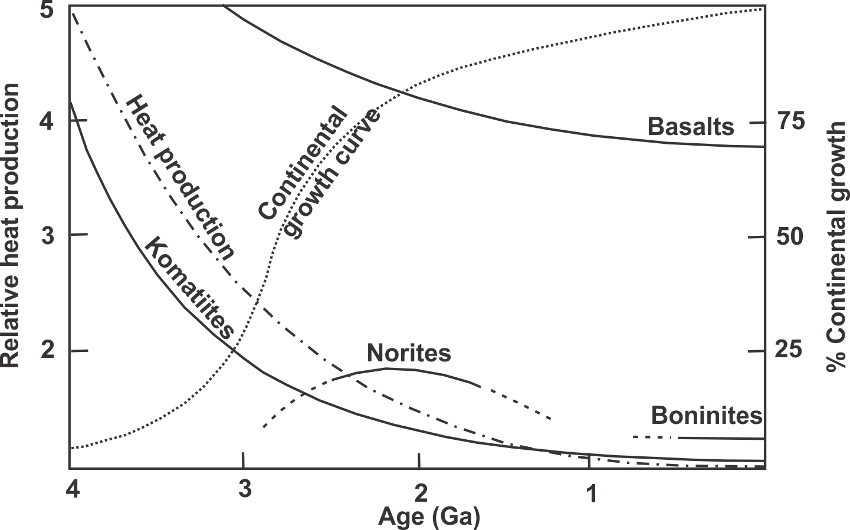
Figure 1: Relative rates of production of basalts, komatiites, norites and boninites with respect to time, continental growth (dotted line), and relative global heat production (dash-dot line). This model is taken from the Hall and Hughes (1990b, 1993).
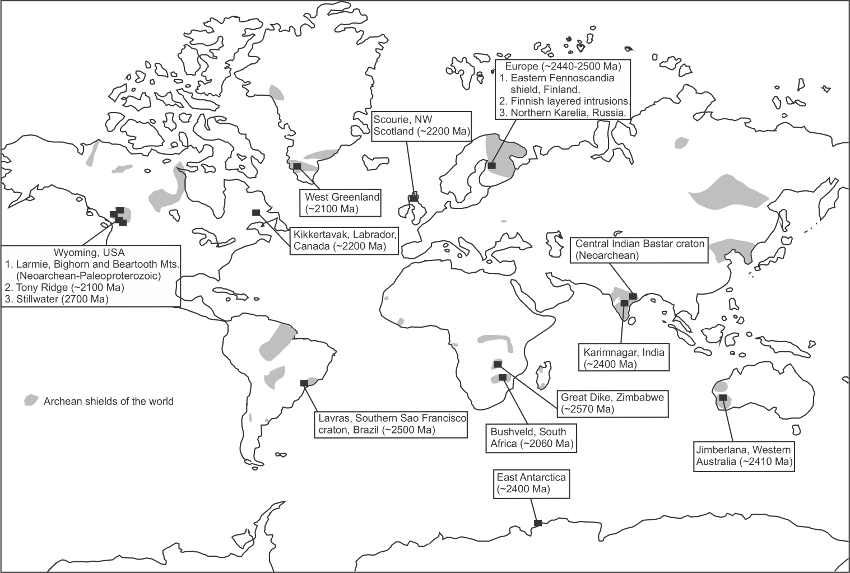
Figure 2: World-wide distribution of Neoarchean-Paleoproterozoic boninite-norite suites emplaced within the Archean craton. See Table 2 for other details and references.
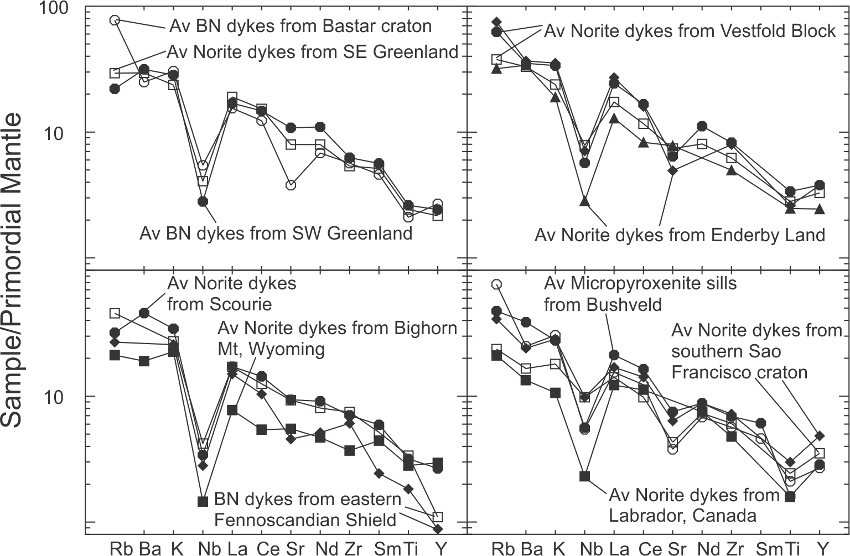
Figure 3: Comparison of Primordial-mantle normalized multi-element spidergrams of average values of boninite-norite suites reported world-wide. Primordial-mantle values are taken from McDonough et al. (1992). See Table 3 for data source.
As discussed earlier, the Neoarchean-Paleoproterozoic high-Mg norites (BN suites) are genetically associated with boninitic rocks and probably derived from a boninitic-type parental magma (Hall and Hughes, 1987, 1990b, 1993; Srivastava, 2006, 2008). It is noted that the boninite-norite (BN) suite differ significantly from Archean komatiite and no genetic association is established between them (Hall et al., 1987; Hall and Hughes, 1990b). Archean komatiites are derived from a high-degree of partial melting of a peridotite source (e.g., Arndt et al., 2008; Cattell and Taylor, 1990; Bickle, 1990), whereas the BN suite of rocks is derived from a depleted refractory mantle which is enhanced by the metasomatism by subduction associated with the assembly at ca. 2.7 Ga of many Archean cratons (e.g., Hall and Hughes, 1990b, Srivastava, 2006).
Smithies et al. (2004) concluded that modern (Phanerozoic) boninites and ancient (Precambrian) high-Mg norites (BN suite) have different petrogenesis. They further suggest that the Archean Whundo type boninite has very similar petrogenetic process as that of modern boninites and may be considered as closest Archean analogues of modern boninites, and to be derived from metasomatism of previously depleted lithosphere in a subduction setting. However, the Whitney-type ‘boninites’ (high-Mg norites) are postulated to have been derived from an extremely depleted garnet-rich source and may be generated by plume-induced melting of (subduction modified?) refractory mantle.
Relation of BN suites with Large Igneous Provinces and Supercontinent breakup
Each of the types of Neoarchean–Paleoproterozoic BN suites with an intracratonic setting has been inferred to be part of a Large Igneous Province (LIP) which also includes major associated basaltic magmatism as well. Ernst and Buchan (2001) have listed a number of large mafic magmatic events (LIPs) induced by mantle plume heads during end of Archean and thereafter (2.6-2.2 Ga); this includes the BN events listed in Table 2: e.g., Great Dyke (Zimbabwe), Vestfold Hills and Napier complex (East Antarctica), Greenland, Fennoscandian shield, Stillwater, Bushveld, Wyoming Province, Slave Province, São Francisco craton (Brazil), eastern Dharwar craton, and others.
As it has been well shown in the younger record (e.g., Ernst and Bleeker 2010: Ernst 2013) every major breakup margin of supercontinents is associated with a LIP. Therefore, the presence of these BN suites is evidence in support of the breakup during the Neoarchean–Paleoproterozoic of a late Archean supercontinent or multiple continents (also termed supercratons; Bleeker 2003). More specifically, Bleeker (2003) has rightly pointed out that a number of ancient cratons were together at the end of Archean and across the Archean-Proterozoic boundary as a supercraton, and Bleeker and Ernst (2006) showed that the breakup history of these Archean supercratons can be linked to the associated LIPs.
Conclusions
Neoarchean–Paleoproterozoic boninite-noritic (BN) intrusions and related SHMB (siliceous high magnesium basalts) volcanic rocks are reported from many Archean terrains around the world. Most of them are emplaced in an intracratonic tectonic setting, and have been considered as parts of Large Igneous Provinces (LIPs). It is noted that the end of widespread komatiite magmatism at the end of Neoarchean is associated with the onset of the period of BN magmatism globally. Then at about 2 Ga BN magmatism becomes rare. The timing of BN magmatism is linked to crustal thickening and associated cratonization at the end of the Archean. Prior to this cratonization event an extensive extraction of mafic magma developed refractory mantle. Later, this refractory mantle was metasomatised by subduction associated with the assembly at ca. 2.7 Ga of many Archean cratons. Eventually partial melting of metasomatised refractory mantle, due to the arrival of mantle plumes, produced boninite-type melts during Neoarchean–Paleoproterozoic. Furthermore the intracratonic setting of BN magmatism and the link with LIPs (which are robustly linked with continental breakup) suggests that the BN magmatism during the Neoarchean–Paleoproterozoic is associated with the breakup of late Archean continents.
References
Alapieti, T., 1982, The Koillismaa layered igneous complex, Finland – its structure, mineralogy and geochemistry, with emphasis on the distribution of chromium: Geological Survey of Finland Bulletin, v. 319, 116 p.
Alapieti, T. and Lahtinen, J. J., 1986, Stratigraphy, petrology and platinum-group element mineralization of the early Proterozoic Penikat layered intrusion, northern Finland: Economic Geology, v. 81, p. 1126-1136.
Alapieti, T., Filen, B. A., Lahtinen, J. J., Lavrove, M. M., Smolkin, V. F. and Voitsekhovsky, S. N., 1990, Early Proterozoic layered intrusions in the northeastern part of the Fennoscandian Shield: Mineralogy and Petrology, v. 42, p. 1-22.
Asahara Y. and Ohtani E., 2001, Melting relations of the hydrous primitive mantle in the CMAS- H2O system at high pressures and temperatures, and implications for generation of komatiites. Physics of the Earth and Planetary Interiors, v. 125, p. 31-44.
Arndt, N. T. and Jenner, G. A., 1986, Crustally contaminated komatiites and basalts from Kambalda, western Australia. Chemical Geology, v. 56, p. 229-255.
Arndt N. and Nisbet E.G., 1982, Komatiites. Allen and Unwin, London, p. 526.
Arndt, N. T., Brögmann, G. E., Lenhert, K., Chappel, B. W. and Chauvel, C., 1987, Geochemistry, petrogenesis and tectonic environment of Circum-Sperior Belt basalts, Canada. Geochemistry and Mineralisation of Proterozoic Volcanic Suites (Pharaoh, T. C., Beckinsdale, R. D. and Rickard, D., eds), 133-146, Blackwell, London.
Arndt, N., Lesher, C. M. and Barnes, S. J., 2008, Komatiite. Cambridge University Press, Cambridge, xiv + 467 pp.
Barnes, S. J., Van Kranendonk, M. J. and Sonntag, I., 2012, Geochemistry and tectonic setting of basalts from the Eastern Goldfields Superterrane. Australian Journal of Earth Sciences, v. 59, p. 707–735.
Bickle, M. J., 1990, Mantle evolution, In Hall, R. P. and Hughes, D. J., eds., Early Precambrian Basic Magmatism: Glasgow, Blackie, p. 111-135.
Bleeker, W., 2003, The late Archean record: a puzzle in ca. 35 pieces. Lithos, v. 71, p. 99-134.
Bleeker, W., and Ernst, R.E., 2006. Short-lived mantle generated magmatic events and their dyke swarms: the key unlocking Earth's paleogeographic record back to 2.6 Ga. In: Hanski, E., Mertanen, S., Rämö, T., Vuollo, J. (Eds.), Dyke Swarms — Time Markers of Crustal evolution. Taylor and Francis Group, London, pp. 3–26.
Brooks C. and Hart S., 1972, An Extrusive Basaltic Komatiite from a Canadian Archean Metavolcanic Belt. Canadian Journal of Earth Sciences, v. 9, p. 1250-1253.
Brooks C. and Hart S. R. (1974) On the significance of komatiite. Geology, v. 2, p. 107-110.
Cadman, A. C., Tarney, J. and Hamilton, M. A., 1997, Petrogenetic relationships between Paleoproterozoic tholeiitic dykes and associated high-Mg noritic dykes, Labrador, Canada. Precambrian Research, v. 82, p. 63-84.
Cameron, W. E., Nisbet, E. G. and Dietrich. V. J., 1979, Boninites, komatiites and ophiolitic basalts. Nature, v. 280, p. 550-553.
Campbell, I. H., 1977, A study of macro-rhythmic layering and cumulate processes in the Jimberlana intrusion: Journal of Petrology, v. 18, p. 183-215.
Campbell, I. H., McCall, G. J. H. and Tyrwhitt, D. S., 1970, The Jimberlana norite, Western Australia – a smaller analogue of the Great Dyke of Rhodesia: Geological Magazine, v. 107, p. 1-11.
Cattell, A. C. and Taylor, R. N., 1990, Archean basic magma, In Hall, R. P. and Hughes, D. J., eds., Early Precambrian Basic Magmatism: Glasgow, Blackie, p. 11-39.
Chalapathi Rao, N.V., and Srivastava, R.K., 2009, A new find of boninite dyke from the Palaeoproterozoic Dongargarh Supergroup: inference for a fossil subduction zone in the Achaean of the Bastar craton, Central India. N.Jb. Miner. Abh. v. 186, no. 3, p. 271-282.
Collerson, K. D. and Sheraton, J. W., 1986, Age and geochemical characteristics of a mafic dyke swarm in the Archaean Vestfold Block, Antarctica: inferences about Proterozoic dyke emplacement in Gondwanaland: Journal of Petrology, v. 27, p. 853-886.
Crawford, A. J., 1989, Boninites and Related Rocks. Unwin Hyman, London, 465 pp.
Crawford, A. J., Falloon, T. J. and Green, D. H., 1989, Classification, petrogenesis and tectonic setting of boninites. Boninites and Related Rocks (Crawford, A. J., ed.), 1-49, Unwin Hyman, London.
Czamanske, G. K. and Zientek, M. L., 1985, Stillwater Complex: Special Publication of Montana Bureau of Mines and Geology, v. 92, 396 p.
Ernst, R.E., 2013 Large Igneous Provinces (LIPs). Cambridge University Press, in preparation.
Ernst, R.E., and Buchan, K.L., 2001. Large mafic magmatic events through time and links to mantle– plume heads. In: Ernst, R.E., Buchan, K.L. (Eds.), Mantle Plumes: Their Identification Through Time. Special Paper, vol. 352. Geological Society of America, Boulder, CO, pp. 483– 575.
Ernst, R. E. and Bleeker, W., 2010, Large igneous provinces (LIPs). Giant dyke swarms, and mantle plumes: significance for breakup events within Canada and adjacent regions from 2.5 Ga to present. Canadian Journal of Earth Sciences, v. 47, p. 695-739.
Falloon, T. J. and Crawford, A. J., 1991, The petrogenesis of high-calcium boninite lavas dredged from the northern Tonga Ridge. Earth Planet. Sci. Lett., v. 102, p. 375-394.
Fletcher, I. R., Libby, W. G. and Rosman, K. J. R., 1987, Sm-Nd dating of the 2411 Ma Jimberlana Dyke, Yilgarn Block, Western Australia: Australian Journal of Earth Sciences, v. 34, p. 523-525.
Gao, J. F. and Zhou, M. F., 2013, Generation and evolution of siliceous high magnesium basaltic magmas in theformation of the Permian Huangshandong intrusion (Xinjiang, NW China). Lithos, v. 162-163, p. 128-139.
Hall, R. P. and Hughes, D. J., 1987, Norite dykes of southern Greenland, early Proterozoic boninitic magmatism: Contribution to Mineralogy and Petrology, v. 97, p. 169-182.
Hall, R. P. and Hughes, D. J., 1990a, Early Precambrian basic magmatism. Blackie, Glasgow, 486 pp.
Hall, R. P. and Hughes, D. J., 1990b, Norite magmatism. Early Precambrian basic magmatism (Hall, R. P. and Hughes, D. J., eds.), 83-110, Blackie, Glasgow.
Hall, R. P. and Hughes, D. J., 1993, Early Precambrian crustal development: changing styles of mafic magmatism: Journal of Geological Society of London, v. 150, p. 625-635.
Hall, R. P., Hughes, D. J., Friend, C. R. L. and Snyder, G. L., 1987, Proterozoic mantle heterogeneity: geochemical evidence from contrasting basic dykes, In Pharaoh, T. C., Beckinsale, R. D. and Richard, D., eds., Geochemistry and Mineralization of Proterozoic Volcanic Suites: Geological Society Special Publication 33, p. 9-22.
Hatton, C. J. and Von Gruenewaldt, G., 1990, Early Precambrian layered intrusions, In Hall, R. P. and Hughes, D. J., eds., Early Precambrian Basic Magmatism: Glasgow, Blackie, p. 56-82.
Hickey, R. L. and Frey, F. A., 1982, Geochemical characteristics of boninite series volcanics: implications for their source: Geochemica et Cosmochimica Acta, v. 46, p. 2099-2115.
Kelemen P.B., 1995. Genesis of high Mg andesites and the continental crust. Contrib. Miner. Petrol., v. 120, p. 1–19.
Kim, J. and Jacobi, R. D., 2002, Boninites: characteristics and tectonic constraints, northeastern Appalachians. Physics and Chemistry of the Earth, v. 27, p. 109–147.
Kuehner, S. M., 1989, Petrology and geochemistry of early Proterozoic high-Mg dykes from the Vestfold Hills, Antarctica. Boninites and Related Rocks (Crawford, A. J., ed.), 208-231, Unwin Hyman, London.
Le Bas, M. J., 2000, IUGS reclassification of the high-Mg and picritic volcanic rocks. Journal of Petrology, v. 41, p. 1467-1470.
Le Maitre, R. W., 2002, Igneous Rocks: A classification and glossary of terms, Second Edition, Cambridge University Press, Cambridge, 236 pp.
McDonough, W. F., Sun, S. -S., Ringwood, A. E., Jagoutz, E. and Hofmann, A. W., 1992, K, Rb and Cs in the earth and moon and the evolution of the earth’s mantle. Geochim. Cosmochim. Acta, v. 56, p. 1001-1012.
McLennan, S. M. and Taylor, S. R., 1982, Geochemical constraints on the growth of the continental crust: Journal of Geology, v. 90, p. 342-361.
Olsson, J. R., Söderlund, U., Klausen, M. B. and Ernst, R. E., 2010, U–Pb baddeleyite ages linking major Archean dyke swarms to volcanic-rift forming events in the Kaapvaal craton (South Africa), and a precise age for the Bushveld Complex. Precambrian Research, v. 183, p. 490–500.
Parman, S.W., and Grove, T.L., 2005, Komatiites in the plume debate. In: Foulger, G.R., Natland, J.H., Presnall, D.C., and Anderson, D.L. (eds.) Plates, Plumes, and Paradigms. Geological Society of America Special Paper 388, p. 249-256.
Piercey, S.J., Murphy, D.C., Mortensen, J.K., and Paradis, S., 2001, Boninitic magmatism in a continental margin setting, Yukon-Tanana terrane, southeastern Yukon, Canada. Geology, v. 29, p. 731–734.
Pinese, J. P. P., Teixeira, W., Piccirillo, E. M., Quémenéur, J. J. G. and Bellieni, G., 1995, The Precambrian Lavras mafic dykes, southern São Francisco craton, Brazil: preliminary geochemical and geochronological results, In Baer, G. and Heimann, A., eds., Physics and Chemistry of Dykes: A.A.Balkema, Rotterdam, p. 205-218.
Raedeke, L. D. and McCallum, I. S., 1984, Investigations in the Stillwater complex. II. Petrology and petrogenesis of the ultramafic series: Journal of Petrology, v. 25, p. 395-420.
Rajesh, H. M., Chisonga, B. C., Shindo, K., Beukes, N. J. and Armstrong, R. A., 2013, Petrographic, geochemical and SHRIMP U–Pb titanite age characterization of the Thabazimbi mafic sills: Extended time frame and a unifying petrogenetic model for the Bushveld Large Igneous Province. Precambrian Research, v. 230, p. 79–102.
Rao, J. M., Rao, G. V. S. P. and Patil, S. K., 1990, Geochemical and paleomagnetic studies on the middle Proterozoic Karimnagar mafia dyke swarm, India, In Parker, A. J., Rickwood, D. H. and Tucker, D. H., eds., Mafic Dykes and Emplacement Mechanisms: A.A.Balkema, Rotterdam, p. 373-382.
Redman, B. A. and Keys, R. R., 1985, Archean basic volcanism in the Eastern Goldfields Province, Yilgarn Block, Western Australia. Precambrian Research, v. 30, p. 113-152.
Rogers, J. J. W., 1996, A history of continents in the past three billion years: Journal of Geology, v. 104, p. 91-107.
Rogers, J. J. W. and Santosh, M., 2003, Supercontinents in Earth history: Gondwana Research, v. 6, p. 357-368.
Sharpe, M. R., 1985, Strontium isotope evidence for preserved density stratification in the main zone of the Bushveld complex: Nature, v. 316, p. 119-126.
Sharpe, M. R. and Hulbert, L. J., 1985, Ultramafic sills beneath the eastern Bushveld complex: mobilized suspensions of early lower zone cumulates in a parental magma with boninitic affinities: Economic Geology, v. 80, p. 849-871.
Sheraton, J. W. and Black, L. P., 1981, Geochemistry and geochronology of Proterozoic tholeiite dykes of East Antarctica: evidence for mantle metasomatism: Contribution to Mineralogy and Petrology, v. 78, p. 305-317.
Sheraton, J. W., Black, L. P., McCulloch, M. T. and Oliver, R. L., 1990, Age and origin of a compositionally varied mafic dyke swarm in the Bunger Hills, East Antarctica. Chemical Geology, v. 85, p. 215-246.
Smirnov, A. V., Evans, D. A. D., Ernst, R. E., Söderlund, U. and Li, Z-X., 2013, Trading partners: Tectonic ancestry of southern Africa and western Australia, in Archean supercratons Vaalbara and Zimgarn. Precambrian Research, v. 224, p. 11–22.
Smithies, R. H., 2002, Archean boninite-like rocks in an intracratonic setting: Earth and Planetary Science Letter v. 197, p. 19-34.
Smithies, R. H. Champion, D. C. and Sun, S. -S., 2004, The case of Archean boninites: Contribution to Mineralogy and Petrology v. 147, p. 705-721.
Söderlund, U., Hofmann, A., Klausen, M. B., Olsson, J. R., Ernst, R. E. and Persson, P. O., 2010, Towards a complete magmatic barcode for the Zimbabwe craton: Baddeleyite U–Pb dating of regional dolerite dyke swarms and sill complexes. Precambrian Research, v. 183, p. 388–398.
Srivastava, R. K., 2006, Geochemistry and Petrogenesis of NeoArchean High-Mg Low-Ti Mafic Igneous Rocks in an Intracratonic Setting, Central India Craton: Evidence for Boninite Magmatism: Geochemical Journal, v. 40, p. 15-31.
Srivastava, R.K., 2008. Global intracratonic boninite-norite magmatism during the NeoArchean-Paleoproterozoic: evidence from the central Indian Bastar Craton. International Geology Review v. 50, p. 61–74.
Srivastava, R. K. and Singh, R. K., 2003, Geochemistry of high-Mg mafic dykes from the Bastar Craton: evidence of Late Archean boninite-like rocks in an intracratonic setting. Current Sci., v. 85, p.808-812.
Srivastava, R. K., Singh, R. K. and Verma, S. P., 2004, Late Archaean mafic volcanic rocks from the southern Bastar greenstone belt, Central India: petrological and tectonic significance. Precambrian Research, v. 131, p. 305-322.
Summers, M. A., Hall, R. P., Hughes, D. J., Nesbitt, R. W. and Snyder, G. L., 1995, The Tony Ridge zoned ultramafic dyke, Wyoming, USA: preliminary geochemical results, In Baer, G. and Heimann, A., eds., Physics and Chemistry of Dykes: A.A.Balkema, Rotterdam, p. 193-204.
Sun, S. -S. and Nesbitt, R. W., 1978, Petrogenesis of Archean ultrabasic and basic volcanism: evidence from rare earth elements. Contributions to Mineralogy and Petrology, v. 65, p. 301-325.
Sun, S. -S., Nesbitt, R. W. and McCulloch, M. T., 1989, Geochemistry and petrogenesis of Archean and early Proterozoic siliceous high-magnesian basalts. Boninites and Related Rocks (Crawford, A. J., ed.), 148-173, Unwin Hyman, London.
Snyder, G. A., Simmons, E. C., Holden, G. S. and Snyder, G. L., 1985, A Nd, Sr, REE geochemical study of early Proterozoic rifting of the Archaean Wyoming craton: evidence for two distinct mantle source regions: Eos, v. 66, p. 415.
Snyder, G. L., Hughes, D. J., Hall, R. P. and Ludwig, K. R., 1989, Distribution of Precambrian intrusives penetrating some Archaean rocks of western North America: U. S. Geological Survey Open File Report, v. 89-125, 36 p.
Tarney, J. and Weaver, B. L., 1987a, Mineralogy, petrology and geochemistry of the Scourie dykes: oetrogenesis and crystallization processes in dykes intruded at depth, In Park, R. G. and Tarney, J., eds., Evolution of the Lewisian and Comparable Precambrian High Grade Terrains: Geological Society of London Special Publication, v. 27, p.217-233.
Tarney, J. and Weaver, B. L., 1987b, Geochemistry and petrogenesis of early Proterozoic dyke swarms, In Halls, H. C. and Fahrig, W. F., eds., Mafia Dyke Swarms: Geological Association of Canada Special Paper 34, p. 81-94.
Tatsumi, Y., 2006,. High-Mg Andesites in the Setouchi Volcanic Belt, Southwestern Japan: Analogy to Archean Magmatism and Continental Crust Formation? Annual Review of Earth and Planetary Science, v. 34, p. 467–499.
Tatsumi, Y. and Maruyama, S., 1989, Boninites and high-Mg andesites: tectonics and petrogenesis. Boninites and Related Rocks (Crawford, A. J., ed.), 50-71, Unwin Hyman, London.
Tatsumi Y, Shukuno H, Sato K, Shibata T, Yoshikawa M. 2003. The petrology and geochemistry of high-Mg andesites at the western tip of the Setouchi volcanic belt, SW Japan. Journal of Petrology, v. 44, p. 1561–78.
Taylor, R. N., Nesbit, R., Vidal, P., Harmon, R. S., Auvray, B. and Croudace, I. W., 1994, Mineralogy, chemistry, and genesis of the boninite series volcanics, Chichijima, Bonin Islands, Japan. Journal of Petrology, v. 35, p. 577-617.
Turchenko, S. I., Semenov, V. S., Amelin, J. V., Levochenkov, O. A., Neymark, L. A., Buiko, A. K. and Kopatev-Devornikov, J. V., 1991, The early Proterozoic riftogenic belt of Northern Karelia and associated Cu-Ni, PGE and Cu-Au mineralization: Geological För. Stockh. Förh., v.113, p. 70-72.
Veizer, J. and Jansen, S. L., 1979, Basement and sedimentary recycling and continental evolution: Journal of Geology, v. 87, p. 341-370.
Von Gruenewaldt, G., Sharpe, M. R. and Hatton, C. J., 1985, The Bushveld complex: introduction and review: Economic Geology, v. 80, p. 803-812.
Vuollo, J. I., Nykänen, V. M., Liipo, J. P. and Piirainen, T. A., 1995, Palaeoproterozoic mafic dyke swarms in the eastern Fennoscandian shield, Finland: a review, In Baer, G. and Heimann, A., eds., Physics and Chemistry of Dykes: A.A.Balkema, Rotterdam, p. 179-192.
Weaver, B. L. and Tarney, J., 1981, The Scourie dyke suite: petrogenesis and geochemical nature of Proterozoic sub-continental mantle: Contribution to Mineralogy and Petrology, v. 78, p. 175-178.
Wilson, A. H., 1982, The geology of the Great “Dyke”, Zimbabwe: the ultramafic rocks: Journal of Petrology, v. 23, p. 240-292.
Wilson A. H. and Versfeld J. A., 1994, The early Archean Nondweni greenstone belt, southern Kaapvaal Craton, South Africa; Part II, Characteristics of the volcanic rocks and constraints on magma genesis. Precambrian Research, v. 67, p. 277-320.
Wilson, J. F., Jones, D. L. and Kramers, J. D., 1987, Mafia dyke swarms in Zimbabwe, In Halls, H. C. and Fahrig, W. F., eds., Mafia Dyke Swarms: Geological Association of Canada Special Paper 34, p. 433-444.
